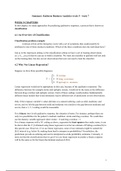Summary Endterm Business Analytics week 5 - week 7
WEEK 5 CHAPTERS
In this chapter, we study approaches for predicting qualitative responses, a process that is known as
classification.
4.1 An Overview of Classification
Classification problem example:
A person arrives at the emergency room with a set of symptoms that could possibly be
attributed to one of three medical conditions. Which of the three conditions does the individual have?
Just as in the regression setting, in the classification setting we have a set of training observations
(x1,y1),...,(xn,yn) that we can use to build a classifier. We want our classifier to perform well not only
on the training data, but also on test observations that were not used to train the classifier.
4.2 Why Not Linear Regression?
Suppose we have three possible diagnoses.
Linear regression would not be appropriate in this case, because of the qualitative responses. The
difference between for example stroke and epileptic seizure, would not be the same as the difference
between drug overdose and epileptic seizure. Each of these codings would produce fundamentally
different linear models that would ultimately lead to different sets of predictions on test observations.
Only if the response variable’s values did take on a natural ordering, such as mild, moderate, and
severe, and we felt the gap between mild and moderate was similar to the gap between moderate and
severe, then a 1, 2, 3 coding would be reasonable.
For a binary (two level) qualitative response, the situation is better. For instance, perhaps there are
only two possibilities for the patient’s medical condition: stroke and drug overdose. We could then
use the dummy variable approach where stroke = 0 and drug overdose = 1.
For a binary response with a 0/1 coding as above, regression by least squares does make sense; it can
be shown that the Xˆ β o btained using linear regression is in fact an estimate of Pr(drug overdose|X) in
this special case. However, if we use linear regression, some of our estimates might be outside the
[0,1] interval (e.g. below 0), making them hard to interpret as probabilities! Nevertheless, the
predictions provide an ordering and can be interpreted as crude probability estimates. Curiously, it
turns out that the classifications that we get if we use linear regression to predict a binary response
will be the same as for the linear discriminant analysis (LDA).
1
,4.3 Logistic Regression
4.3.1 The Logistic Regression Model
How should we model the relationship between p( X)=Pr(Y=1|X) and X? (For convenience we are
using the generic 0/1 coding for the response).
To avoid the problem that p will be lower than 0 or higher than 1, we must model p(X) using a
function that gives outputs between 0 and 1 for all values of X. Many functions meet this description.
In logistic regression, we use the logistic function
To fit the model, we use a method called maximum likelihood, which we discuss in the next section.
The logistic function will always produce an S-shaped curve of this form, and so regardless of the
value of X, we will obtain a sensible prediction.
After a bit of manipulation of the above formula, we find that
The quantity p( X)/[1−p(X)] is called the odds, and can take on any value between 0 and ∞. Values of
the odds close to 0 and ∞ indicate very low and very high probabilities of default, respectively. By
taking the logarithm of both sides of the above formula, we arrive
The left-hand side is called the log-odds or logit. In a logistic regression model, increasing X by one
unit changes the log odds by β1, or equivalently it multiplies the odds by eβ1. The amount that p( X)
changes due to a one-unit change in X will depend on the current value of X. But regardless of the
value of X, if β1 is positive then increasing X will be associated with increasing p( X), and if β1 is
negative then increasing X will be associated with decreasing p(X)
4.3.2 Estimating the Regression Coefficients
We could use (non-linear) least squares to fit the model, but the more general method of maximum
likelihood is preferred, since it has better statistical properties.
The basic intuition behind using maximum likelihood to fit a logistic regression model is as follows:
we seek estimates for β0 and β1 such that the predicted probability ˆp(xi) of default for each
individual, corresponds as closely as possible to the individual’s observed default status. In other
words, we try to find ˆβ0 and ˆβ1 such that plugging these estimates into the model for p(X), yields a
number close to one for all individuals who defaulted, and a number close to zero for all individuals
who did not. This intuition can be formalized using a mathematical equation called a likelihood
function:
2
, The estimates ˆβ0 and ˆβ1 are chosen to maximize this likelihood function.
4.3.3 Making Predictions
Once the coefficients have been estimated, it is a simple matter to compute the probability of Y for
any given X. For example, the probability below is less than 1%
One can use qualitative predictors with the logistic regression model using the dummy variable
approach explained in 4.2.
4.3.4 Multiple Logistic Regression
We now consider the problem of predicting a binary response using multiple predictors. By analogy
with the extension from simple to multiple linear regression in Chapter 3, we can generalize the
simple logistics regression formula as follows:
where X = (X1,...,Xp) are p predictors. This equation can be rewritten as
Again, we use the maximum likelihood method to estimate the coefficients.
Confounding
A phenomenon where the results obtained using one predictor may be quite different from those
obtained using multiple predictors, especially when there is correlation among the predictors.
Table 4.2 only has student status as a predictor. Table 4.3 has 2 predictors, credit card balance and
students status.
3







